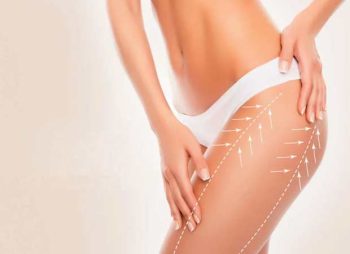The thigh lift is a surgical procedure that removes excess skin and fat from the inside or outside of the thigh. This surgery is usually a desirable procedure after a large weight loss and when diet or exercise fail to firm loose skin. Liposuction can be used as a fit on the contour of the inner thigh. If you are committed to maintaining a healthy lifestyle and a moderate weight, thigh lifting can help you regain the contours of the thigh you want.
What is the thigh lift surgery?
The thigh lift surgery is an operation that surgically removes excess skin and adipose tissue to recover sagging in the inner-outer region of the thigh and hip. It can be performed simultaneously with the body lifting operation (lipectomy) to improve the overall contours of the body.
Different methods can be used in the thigh lift surgery. Depending on the degree of need of the body, lipolysis laser, lipomatic or liposuction are some of them.
Leg stretching procedures, used in cases where applications such as sports, diet and massage are insufficient, recover relaxation in the thigh region with soft tissues and aim to correct deformations.
Advantages of thigh lift
Leg stretching surgery, required in cases such as sudden excessive weight loss, post-pregnancy, is the easiest and fastest process of recovery from sagging observed with loss of elasticity. It is the only way to treat excessive sagging that cannot be solved with sports or a healthy diet.
Sagging in the thigh region can sometimes be at a level that can cause discomfort in patients due to friction. Especially in summer, this friction brings problems such as rash or fungi, depending on the clothing used. Considering all these problems, thigh stretching becomes necessary. As this procedure avoids health problems and also eliminates the aesthetic concerns of the person, it is recommended that people with sagging thigh consult a specialist.
What should be considered before surgery?
Since it affects the blood and oxygen going into the tissues, smoking should be stopped 2 to 3 months before the operation. The person should also stop using anticoagulants in the 2 weeks prior to surgery. If there is a medical condition, such as high blood pressure, it should be checked before surgery. When examining a series of tests requested by the expert, the operation process can be decided when no problems are seen.
Who can be done?
The stretching process, in which excess tissues of the leg skin are removed and tightened in the desired shape, can be applied to anyone over 18 who requires this procedure. It is preferable in loosening the skin by excessive weight loss, excess in the leg region after birth, sagging of the skin of the leg with age. In examinations performed by specialists of the promed clinic, the process is planned if there is no obstacle to surgery.
A good candidate for thigh lifting
- Who has a significant looseness on the skin of the arm
- Who has relatively stable weight and who is not significantly overweight
- Healthy
- Non-smokers
- Individuals with a positive outlook and realistic expectations.
Preparation for thigh lifting surgery
- Consult the surgeon for your goals, perform a physical examination, a laboratory test, chest x-ray and a medical evaluation
- Take certain medications or adjust your current medications as instructed by your surgeon
- Stop smoking before and after surgery two weeks
- Avoid taking aspirin, anti-inflammatory drugs and herbal supplements as they may increase bleeding

Thigh lifting procedure:
- Surgery is performed under general anesthesia.
- The surgeon marks the incisions to remove excess skin and fat. Depending on the desired amount, the incision may extend around the thigh or only part of the path around the inner part of the thigh.
- After the incision, the surgeon elevates the skin and fat of the underlying muscles of the thighs and removes excess skin and fat to reshape the thighs. Drains can be placed under the incision.
- The incisions are carefully closed in several layers of strong sutures to minimize their scarring. The surgeon uses a technique in which the sutures are under the skin and are absorbed by the body. The skin will be sewn.
The lifting surgery of the thigh takes approximately 4-5 hours.
Postoperative care for thigh lifting
- Wear compression clothing to support the thighs and decrease swelling for at least 6-8 weeks
- During healing, it is necessary to lift the knee when sleeping to reduce swelling.
- Typical symptoms after surgery are bruising, swelling and some pain within a few weeks. Contact the surgeon if the pain, redness and swelling are signs of a problem.
- Remove the stitches after surgery seven days.
- Attend from all medical appointments.
- Avoid strenuous activities that interfere with the thighs to prevent scar rupture. At least for six weeks.
Risks and complications:
- Scarring
- The scar is quite long and dressings are needed every day to prevent infections.
- Patients should wear compression clothing, required 24 hours a day, for at least one month. The compression piece helps support the legs during healing, decreasing postoperative swelling and preventing the scar.
- Bad healing, maybe ruptured. The suture will occur again.
- Fluid accumulation (seroma)
- Damage to deeper structures such as nerves, blood vessels and muscles
- Necrosis of fat and tissue.
- Numbness or decreased skin sensation
- Pain
- Asymmetry
Thigh lifting recovery:
A sterile dressing is applied to incisions every day and a compression garment is worn on the thighs for at least a month. This compression piece helps support the legs during healing, decreases postoperative swelling and helps reduce any bruising that may occur. You can return to work after surgery a week, but should avoid strenuous activities for six weeks. The scars will be visible, but they could disappear for a year.































